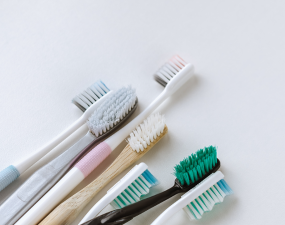Maintaining good oral hygiene is important for your overall health and well-being. An important step in doing so is choosing the right toothbrush and toothpaste.


Maintaining good oral hygiene is important for your overall health and well-being. An important step in doing so is choosing the right toothbrush and toothpaste.
Here are some tips to help you make an informed decision:
If the following situations occur, you need to replace your toothbrush:

- The color of the toothbrush root becomes darker
Dirt at the root of the toothbrush will slowly accumulate. Once you find that the color of the root of the toothbrush becomes darker, it indicates that more dirt has accumulated and the toothbrush needs to be replaced in time.
- Toothbrush wear and deformation
The bristles are soft and collapsed, and the distance between the bristles is significantly wider, making it easier for dirt to accumulate at the root of the toothbrush. When this happens, it is best to replace the toothbrush immediately.
- After a cold
The general cycle of a cold is about 7 days, but the contagiousness of cold viruses will last 7 to 21 days. Even if the cold is gone, cold viruses are likely to be transmitted to the toothbrush. Therefore, when you first recover from a cold, you should replace your toothbrush in time to avoid secondary infection.
- Replace your toothbrush at least once every three months
3 months is the maximum lifespan of a toothbrush, because the toothbrush is in a wet state for a long time and can easily breed bacteria.
Some people always experience gum bleeding, gum swelling and pain after brushing their teeth. In fact, many of these are caused by secondary pollution of the oral cavity caused by bacterial growth on the toothbrush!
toothpaste

- Is fluoride toothpaste good?
There is no doubt that fluoride toothpaste must be beneficial. The "Oral Health Guide for Chinese Residents" points out that fluoride toothpaste is effective in preventing dental caries (cavities).
Many people worry that long-term use of fluoride toothpaste will cause dental fluorosis. In fact, dental fluorosis mainly affects the development of teeth when excessive fluoride intake during the growth and development period of children (within 6 to 8 years old). If you are an adult , yes, that's no problem.
In other words, there is no problem for adults to use fluoride toothpaste, but because children are prone to swallowing toothpaste foam during brushing, it is not recommended for children under 3 years old to use fluoride toothpaste.
- Change toothpaste brands frequently
Long-term use of the same toothpaste may cause some harmful oral bacteria to become resistant and resistant to antibiotics, making the toothpaste ineffective. Changing the type of toothpaste frequently can maintain normal oral flora and is beneficial to dental health.
- Before brushing your teeth, should the toothpaste be soaked in water?
If you are using ordinary toothpaste, it will not matter whether you wet it with water before brushing your teeth; but if you are using desensitizing toothpaste, it is best not to wet it with water to avoid destroying the active ingredients in the toothpaste.
Experts have proven that the ingredients of desensitizing toothpaste are different from ordinary toothpaste. They will form a repair layer on the surface of the teeth. To avoid destroying this active ingredient, it is better not to wet the toothbrush when using desensitizing toothpaste. Squeeze the toothpaste onto a dry toothbrush. Brush your teeth.
- Family members should not share toothpaste
Some families share the same toothpaste, but they don’t know that many oral diseases can be cross-infected.
Sharing the same toothpaste, if one of them catches a cold or suffers from oral disease, cold viruses and oral bacteria can easily remain in the gaps between the toothbrush bristles when brushing. When the toothpaste mouth and toothbrush rub against each other, viruses and bacteria can be transmitted. onto other people's toothbrushes. So, it's best for everyone to have their own toothpaste.
When brushing your teeth, pay attention
It takes at least 3 minutes.
Brush your teeth at least twice a day, once in the morning and once in the evening.
Don’t miss the blind spots when brushing your teeth, such as your tongue.
In addition, I would like to remind everyone that even if we carry out effective brushing and interdental cleaning measures, we can only remove 70% of the tartar. Therefore, it is best to go to a professional dental medical institution for oral examination regularly (on average every six months to one year) and perform oral health care (such as teeth cleaning, etc.), which can also detect oral diseases early.


